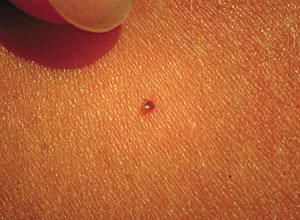 | This image of a Lyme disease-carrying tick burrowing into the skin of a human shows the tiny scale of the insect compared to a human finger nail. |
Direct field evidence shows that Lyme disease in humans can be prevented by vaccinating wildlife, researchers in the Department of Epidemiology and Public Health at the School of Medicine report in the Proceedings of the National Academy of Sciences.
In a four-year study of isolated woodlands near New Haven, nearly 1,000 white-footed mice were trapped and either vaccinated against Lyme disease or given a placebo. Fewer deer ticks tested positive for Lyme disease in the experimental plots where mice had been vaccinated. Fewer ticks carrying infection reduced the risk for humans getting Lyme disease from a tick bite.
"Vaccinating wildlife increases our prevention options," says principal investigator Durland Fish, professor of epidemiology at Yale, who led the study with Jean Tsao, now at Michigan State University, and microbiologist Alan Barbour at the University of California at Irvine.
"Despite a record increase in cases, efforts to prevent Lyme disease with a human vaccine were set back in 2002 when it was pulled from the market due to poor sales," notes Fish.
Although the study showed significant reduction in risk and was the first demonstration of a wildlife vaccination effect for any vector-borne disease, the reduction was not as great as the investigators had hoped.
A surprising result was that mice are not as important in maintaining the Lyme disease bacterium in nature as previous studies showed, says Fish.
"If only mice were responsible for infecting the ticks, we would have seen a much greater reduction," Fish explains. "We now believe that mice are responsible for only 27% to 55% of the infection found in ticks. This changes our view on how Lyme disease is circulated between wildlife and ticks."
Fish says that in addition to mice, other animals must receive Lyme disease vaccination in order to further reduce risk to humans. Oral vaccines, similar to those currently used against rabies, could be developed for Lyme and other vector-borne human diseases that are maintained by wildlife, including West Nile encephalitis, he notes.
Co-authors include J. Timothy Woolton, Jonas Bunkis and Maria Gabriela Luna.
-- By Karen Peart
T H I S
Study suggests vaccinating wildlife may be a key to preventing Lyme disease in humans W E E K ' S
W E E K ' S S T O R I E S
S T O R I E S![]()
 AIA honors British Art Center for its 'enduring significance'
AIA honors British Art Center for its 'enduring significance'![]()
![]()
 Saybrook Orchestra aims to inspire young music lovers
Saybrook Orchestra aims to inspire young music lovers![]()
![]()
 Making spirits bright
Making spirits bright![]()
![]()
 Three scientists win $1 million for research on infectious disease
Three scientists win $1 million for research on infectious disease![]()
![]()
 ENDOWED PROFESSORSHIPS
ENDOWED PROFESSORSHIPS Carlson appointed to Higgins Professorship
Carlson appointed to Higgins Professorship
![]()
 Elimelech has been named to Goizueta Chair
Elimelech has been named to Goizueta Chair![]()
 Jacobs-Wagner is new Singer Assistant Professor
Jacobs-Wagner is new Singer Assistant Professor![]()
![]()
 Dr. Merson to step down as EPH dean
Dr. Merson to step down as EPH dean![]()
![]()
 Study suggests vaccinating wildlife may be a key to . . .
Study suggests vaccinating wildlife may be a key to . . .
![]()
![]()
 In Focus: The Learning Center
In Focus: The Learning Center
![]()
![]()
 Fellowship to bring together architecture students, developers
Fellowship to bring together architecture students, developers
![]()
![]()
 Researchers find the drug Ritalin is effective both for children . . .
Researchers find the drug Ritalin is effective both for children . . .![]()
![]()
 Arts Library acquires the archive of pioneering book artist Richard Minsky
Arts Library acquires the archive of pioneering book artist Richard Minsky![]()
![]()
 United Way Campaign honors Yale departments for their efforts
United Way Campaign honors Yale departments for their efforts
![]()
![]()
 Study links unconscious race bias to particular brain region
Study links unconscious race bias to particular brain region
![]()
![]()
 Artist Franck donates sculpture to ISM
Artist Franck donates sculpture to ISM
![]()
![]()
 Study: Brain's nicotine receptors also a target for antidepressants
Study: Brain's nicotine receptors also a target for antidepressants
![]()
![]()
 Supports help maltreated children who are prone to depression, study finds
Supports help maltreated children who are prone to depression, study finds
![]()
![]()
 Awards to fund innovative theological courses
Awards to fund innovative theological courses
![]()
![]()
 New journal explores globalization's impact on health . . .
New journal explores globalization's impact on health . . .![]()
![]()
 Linda Degutis to chair national public health group
Linda Degutis to chair national public health group
![]()
![]()
 Artistic tribute
Artistic tribute
![]()
Bulletin Home |
| Visiting on Campus
Visiting on Campus |
| Calendar of Events
Calendar of Events |
| In the News
In the News![]()
Bulletin Board |
| Classified Ads
Classified Ads |
| Search Archives
Search Archives |
| Deadlines
Deadlines![]()
Bulletin Staff |
| Public Affairs
Public Affairs |
| News Releases
News Releases |
| E-Mail Us
E-Mail Us |
| Yale Home
Yale Home